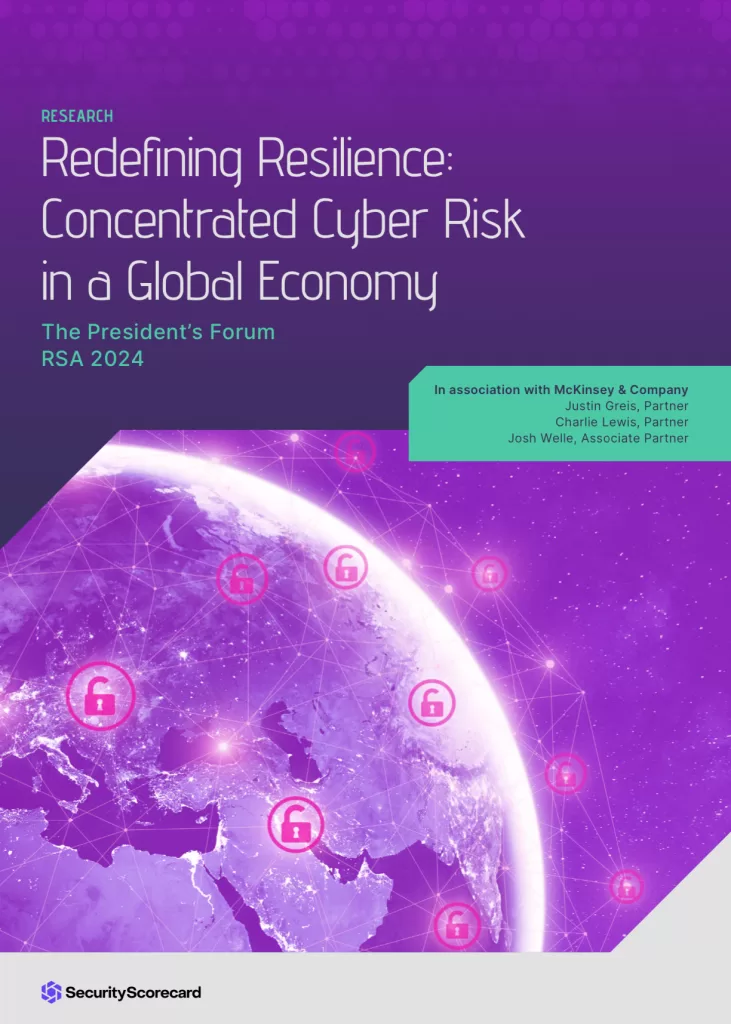In the report “Redefining Resilience: Concentrated Cyber Risk in a Global Economy,” produced by SecurityScorecard in collaboration with the RSA 2024 President’s Forum and McKinsey & Company, the vast scale of the global economy and its profound reliance on digital commerce are scrutinized through the lens of cybersecurity. As the digital footprint of global commerce expands, so too does the vulnerability to cyber threats, which can disrupt economies and jeopardize national security. This report delves into the critical issue of concentrated cyber risk, highlighting how a limited number of technology providers underpin much of our digital and economic infrastructure, thereby magnifying potential risks and impacts.
You can get the full report here. Below is some of what we took away from it.

Tackling Concentrated Cyber Risk in Our Interconnected World
A single cybersecurity breach can have far-reaching consequences in an era where global economies depend heavily on digital infrastructures. Cyber threats, both sophisticated and increasingly prevalent, challenge companies and governments to mount a daunting defense. The interconnectivity of services means that vulnerabilities in one area can compromise entire systems, drawing a direct line from cybersecurity to national security concerns.
The High Cost of Cyber Vulnerabilities
Recent incidents, such as the cyberattack on Change Healthcare, have brought to light the substantial financial and operational costs associated with cybersecurity breaches. This specific attack halted medical claims processing, costing companies like UnitedHealth nearly $872 million. The healthcare industry experienced the ripple effects, demonstrating the severe impact of cyber incidents on both revenue and service delivery. Moreover, a survey revealed that 60% of hospitals experienced a daily revenue impact of $1 million during the outage.
Concentration of Cyber Risk: A Global Issue
Research has highlighted a disturbing trend in the cyber risk landscape: a small number of companies control a significant portion of the technology market, thereby centralizing the risk. About 150 companies dominate 90% of the global attack surface, with just 15 of these companies holding a disproportionately large share. This concentration not only makes the companies themselves prime targets but also magnifies the potential damage of a breach affecting any of them. Furthermore, 41% of these companies have shown evidence of compromised devices within the last year.
Vulnerabilities Exploited by Malicious Actors
The report outlines how threat actors exploit these concentrated vulnerabilities to enact widespread damage, including state-sponsored groups and ransomware syndicates like C10p, LockBit, and BlackCat. For example, the MOVEit software breach impacted millions, with an estimated total cost reaching nearly $10 billion. These incidents underscore the necessity for robust cybersecurity measures that extend beyond individual companies to encompass their entire supply chains.
Strategic Actions to Enhance Cyber Resilience
To combat these risks, organizations are advised to adopt a series of strategic measures:
- Understanding Critical Dependencies: Companies must identify and monitor the security practices of essential third-party vendors to avoid single points of failure.
- Improving Cybersecurity Posture: Regular assessments and upgrades of cybersecurity measures are crucial to avoid potential threats.
- Collaborative Defense Strategies: Firms are encouraged to collaborate with peers and government agencies to strengthen collective security measures and reduce the risk of widespread disruptions.
A Call to Action for Cybersecurity Leaders
Leaders across industries must act on the pressing need for enhanced cybersecurity resilience. By investing in advanced defensive technologies and fostering a culture of continuous improvement and collaboration, businesses can better protect themselves and their stakeholders from the devastating impacts of cyber threats.

Conclusion: Building a More Secure Tomorrow
The journey towards cyber resilience is complex and challenging but essential for safeguarding our digital future. By proactively addressing concentrated cyber risks, we can fortify our infrastructures against emerging threats and ensure the stability and security of global economies. Dr. Aleksandr Yampolskiy, CEO and Co-Founder of SecurityScorecard, poignantly remarks, “Much like a precarious house perched on a cliff’s edge, the reliance on a handful of vendors shapes the foundation of our global economy. The question to ask is: ‘Have we concentrated a mission-critical service to a single vendor — creating a single point of failure?’” This pivotal question drives home the need for diversified resilience in our interconnected digital landscape.
Full Report Here.
Other News: Cybercrime Boom: Great American Beefs Up Cyber Insurance(Opens in a new browser tab)
